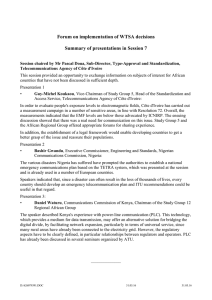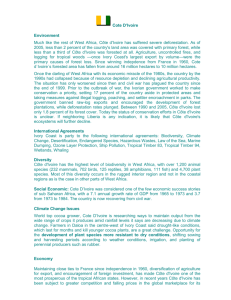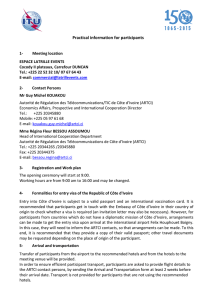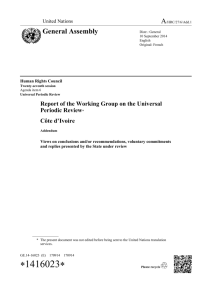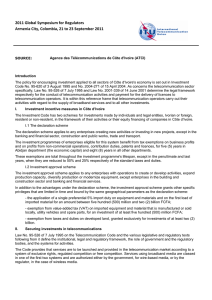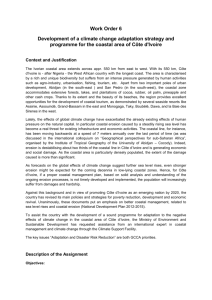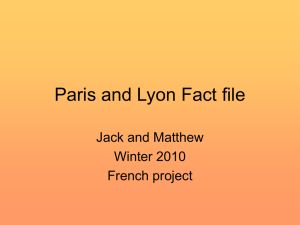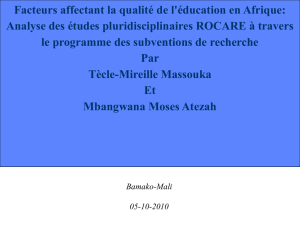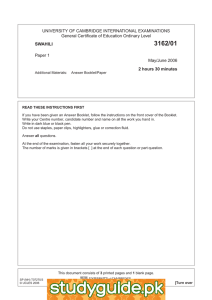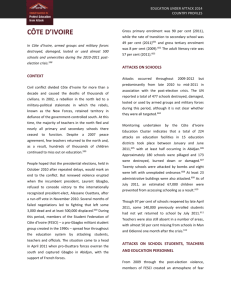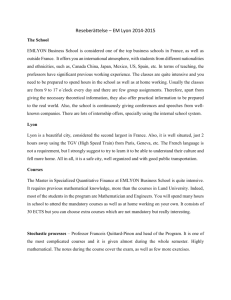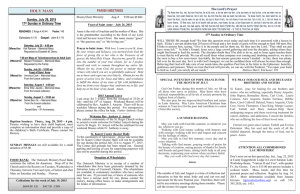3L international Summer School / Lyon (France)
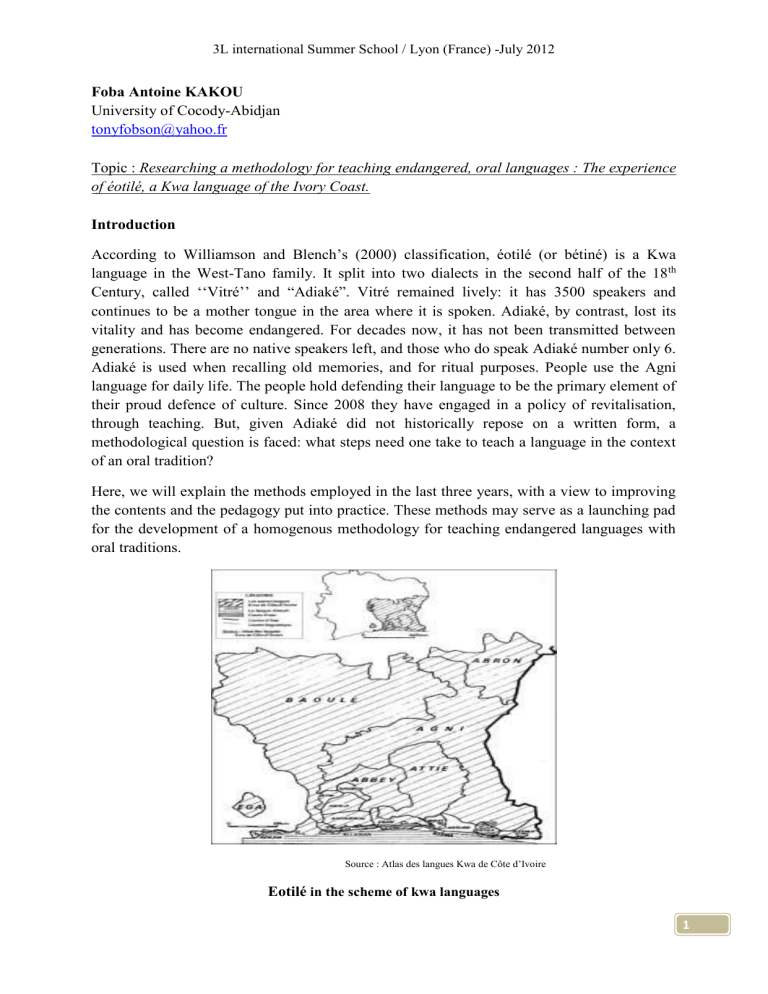
3L international Summer School / Lyon (France) -July 2012
Foba Antoine KAKOU
University of Cocody-Abidjan tonyfobson@yahoo.fr
Topic : Researching a methodology for teaching endangered, oral languages : The experience of éotilé, a Kwa language of the Ivory Coast.
Introduction
According to Williamson and Blench’s (2000) classification, éotilé (or bétiné) is a Kwa language in the West-Tano family. It split into two dialects in the second half of the 18 th
Century, called ‘‘Vitré’’ and “Adiaké”. Vitré remained lively: it has 3500 speakers and continues to be a mother tongue in the area where it is spoken. Adiaké, by contrast, lost its vitality and has become endangered. For decades now, it has not been transmitted between generations. There are no native speakers left, and those who do speak Adiaké number only 6.
Adiaké is used when recalling old memories, and for ritual purposes. People use the Agni language for daily life. The people hold defending their language to be the primary element of their proud defence of culture. Since 2008 they have engaged in a policy of revitalisation, through teaching. But, given Adiaké did not historically repose on a written form, a methodological question is faced: what steps need one take to teach a language in the context of an oral tradition?
Here, we will explain the methods employed in the last three years, with a view to improving the contents and the pedagogy put into practice. These methods may serve as a launching pad for the development of a homogenous methodology for teaching endangered languages with oral traditions.
Source : Atlas des langues Kwa de Côte d’Ivoire
Eotilé in the scheme of kwa languages
1
3L international Summer School / Lyon (France) -July 2012
1.
Background to the death of éotilé
The éotilé people suffered defeat in a war against a neighbouring people in 1754 (Diabaté,
1984). This precipitated an exodus into more peaceful surrounding regions. Those who migrated westward had the privilege of conserving their language, despite language contact and difficult circumstances. Eventually, they settled in the Grand-Bassam sub-prefecture.
Those éotilé people who migrated eastwards settled in Efiè, however, fraught relations with the other group of the area resulted in the éotilé people having to ask the masters of their new lands to permit the éotilé to return to their originals homelands, the Aby Lagoon islands.
(Allou K., 2006). Permission came upon two conditions: a) the éotilé people had to submit to the agni-Sanwi kingdom and b) they had to renounce their language. The éotilé people followed through on this renunciation, in order to survive. As a result, éotilé was not transmitted in actuality across generations. Its vitality waned little by little, following each death of a speaker, while agni became the mother tongue of new generations. In the 19 th
Century, colonisation by the French ended agni people control of the region, but this was insufficient to fix the problem of the cessation of inter-generational transmission of éotilé.
Over the next century, éotilé was reduced to subaltern usage, for example in celebrations of rites. UNESCO grades éotilé as moribund, despite the vitality of the Vitré dialect.
Source : IGT-LATIG, juin 1999
Locations of
éotilé
villages in the South-Comoé region
2
3L international Summer School / Lyon (France) -July 2012
2.
Revitalisation of Eotilé through schooling
Conscious of the key role of language in valorisation of identity, the éotilé people have been partnering for four years with Consciente Institute of Applied Linguistics 0at the University of
Cocody-Abidjan to implement a policy of revitalisation and to safeguard the linguistic heritage and culture of Eotilé. This takes the form of a teaching program each August at
N’Galiwa, an éotilé village. (The 2011 session was not held, because of socio-political instability in Ivory Coast.)
3.1 The methodology of the first session: 2008
Given éotilé was moribund; the actors (the Eotilé community and linguists) thought it useful to start the program with children and teens who could read and write; that way, the program could follow schooling norms. Children were chosen over adults because they possess a better disposition for learning. To have the same level of learning available to children in the ten
Eotilé villages, children were chosen from each.
One hundred children came to N’Galiwa for a month of study. The class has a linguist, a language consultant and a supervisor. The course had three components: reading; writing; vocabulary. The objective of the teaching was to enable to children to read the 39 symbols in the phonetic alphabet of éotilé and to combine them into complex sounds. Each sound was studies in a five-step process:
1.
The sound was inserted in a key word represented by an image. The key word was then broken down into syllables.
2.
The sound was associated with other sounds which had already been covered in class, to obtain monosyllabic words.
3.
A game involving altering syllables enabled a comparison.
4.
Then the students did an exercise opposing the sound to others they had studied.
5.
Finally, the students were invited to construct new words using the sound.
The class materials included a (pre)syllabus and a mini-lexicon. The appropriateness of the methodology was tested through the course’s final exam.
3.2 The methodology in 2009
The second time around, the actors consolidated the methods from the first session. The starting point for reading and writing was adjusted for those at level one (i.e. starting in 2009).
For the level two students (the 2008 group), they began with a recap of the knowledge learnt in session one. The emphasis was on the capacity of the learners to hold conversations unassisted. This was a way to introduce a component called “everyday communication”. To practice, learners were put in realistic situations derived from texts from the syllabus and from general interest. A role play was then performed exclusively in éotilé before the other learners and staff.
3
3L international Summer School / Lyon (France) -July 2012
This gave a motivation to the learners to get used to using their language in social interactions of numerous sorts. This communication exercise was reinforced by a study of the lexicon.
3.2 The methodology in 2010
The 2010 session had three objectives to reach: first, to enable the new recruits to read and write the éotilé alphabet. Next, to develop the 2009 recruits’ aptitude for conversing without assistance in role play games. Finally, for the 2008 recruits, to create an environment that brought their various pieces of acquired knowledge together and to give an appreciation of the exterior world beyond the language.
The first two objectives will not seem new, however, the third was, as the content was left to be defined. To take the students to the end of their studies, the actors introduced three disciplines: knowledge of the éotilé world; éotilé grammar; and conjugations in éotilé.
The first disciple covered the stages of the history of the éotilé people in order for learners to better understand the values of Eotilé identity and the relations developed between their own people and neighbouring peoples.
Grammar and conjugation were purely to enable learners to become speakers capable of constructing, by themselves, unrestricted phrases based on the rules of the function of the language. These two subjects were taught in agni (the more common language of the area), based on the data in the thesis of KAKOU Foba (2009).
Conclusion
Choosing to revitalise a language through teaching is a felicitous initiative. Nevertheless, such an undertaking may bring difficulties with it, where the language is traditionally an oral one
(as in the case of éotilé). In such cases, the actors often find themselves facing methodological problems and each team of actors must use their imagination to overcome the difficulties.
Teaching seemed appropriate to us. So we developed a methodological approach which takes into account the environment of the language. It has been shaped over three years of experimentation. Nevertheless, this methodological approach is not yet complete: the actors in the teaching of éotilé are keen to hear as many opinions and suggestions as possible.
Bibliography
DIABATE, H. D. (1984)
Le Sannvin, un royaume Akan de la Côte d’Ivoire 1701-1901
.
Sources orales et histoire. Univ. de Paris 1, UER d’histoire, Thèse d’Etat, vol.
HELLER, M. & DUCHÊNE, A. (2007). Discourses of endangerment: sociolinguistics, globalization and social order. In Duchêne, A & Heller, M. (2007). Discourse of
Endangerment. Interest and Ideology in the Defense of Languages. London, New York:
Continuum
HERAULT, G. 1982(a) ‘‘ L’éotilé’ ’ in Hérault G (dir.), Atlas des langues Kwa de Côte d’Ivoire, Tome 1
Abidjan, ILA-ACCT
4
3L international Summer School / Lyon (France) -July 2012
KAKOU FOBA A. (2011)
Evaluation du degré de vitalité du betine (éotilé), langue Kwa de
Côte d’Ivoire : Vers une révision de sa classification parmi les langues mortes.
Communication au 27ème Congrès de la Société Linguistique de l’Afrique de l’Ouest : typologie et documentation des langues, 18 août 2011 à l’ENSEA d’Abidjan (Côte d’Ivoire).
KAKOU FOBA A. (2009) Le beti, Programme « Sorosoro » de la fondation
Chirac.
www.sorosoro.org/le-beti
KAKOU FOBA A. (2009)
Syntaxe de l’éotilé, langue kwa de Côte d’Ivoire (parler de Vitré).
Thèse pour le Doctorat unique. Institut de Linguistique Appliquée, Université de Cocody-
Abidjan
KOBLAN, K. (2003)
L’esthétique, sa portée éducative et formative à travers les tambours
Ehotilé
, Thèse pour le doctorat unique, option Arts plastiques. Université de Cocody-Abidjan
PERROT, C. H. (2008) Les Eotilé de Côte d’Ivoire au XVIII et XIX siècles. Pouvoir lignager et religion . Les publications de la Sorbonne.
5
